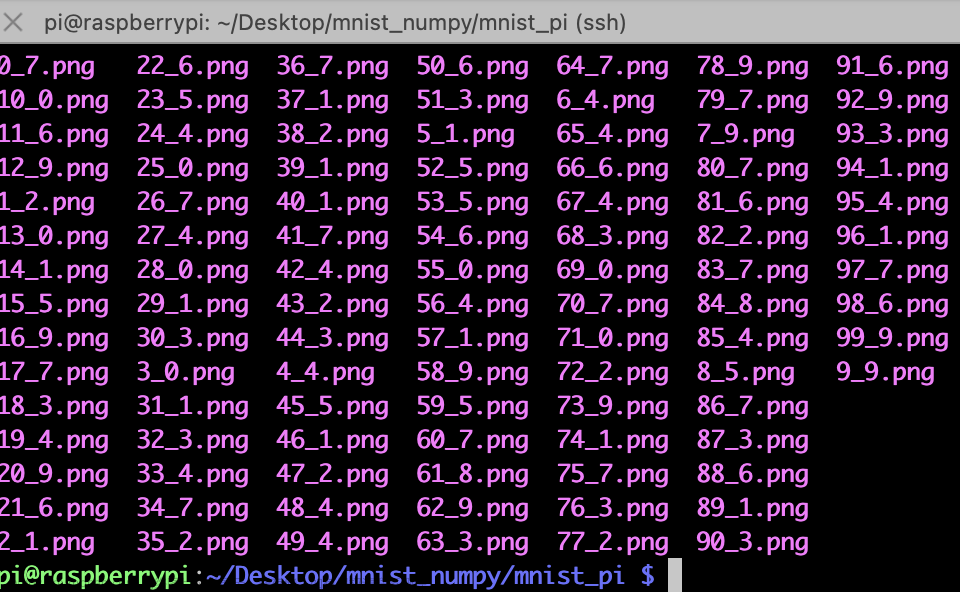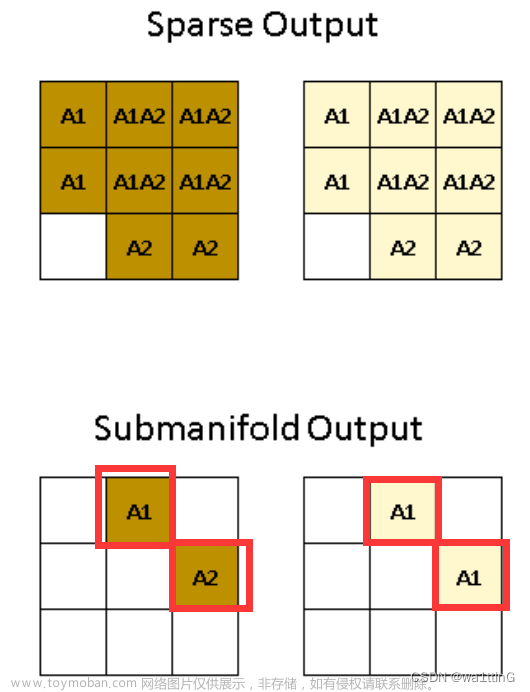这几天又在玩树莓派,先是搞了个物联网,又在尝试在树莓派上搞一些简单的神经网络,这次搞得是卷积识别mnist手写数字识别
训练代码在电脑上,cpu就能训练,很快的:
import torch import torch.nn as nn import torch.optim as optim from torchvision import datasets, transforms import numpy as np # 设置随机种子 torch.manual_seed(42) # 定义数据预处理 transform = transforms.Compose([ transforms.ToTensor(), # transforms.Normalize((0.1307,), (0.3081,)) ]) # 加载训练数据集 train_dataset = datasets.MNIST('data', train=True, download=True, transform=transform) train_loader = torch.utils.data.DataLoader(train_dataset, batch_size=64, shuffle=True) # 构建卷积神经网络模型 class Net(nn.Module): def __init__(self): super(Net, self).__init__() self.conv1 = nn.Conv2d(1, 10, kernel_size=5) self.pool = nn.MaxPool2d(2) self.fc = nn.Linear(10 * 12 * 12, 10) def forward(self, x): x = self.pool(torch.relu(self.conv1(x))) x = x.view(-1, 10 * 12 * 12) x = self.fc(x) return x model = Net() # 定义损失函数和优化器 criterion = nn.CrossEntropyLoss() optimizer = optim.SGD(model.parameters(), lr=0.01, momentum=0.5) # 训练模型 def train(model, device, train_loader, optimizer, criterion, epochs): model.train() for epoch in range(epochs): for batch_idx, (data, target) in enumerate(train_loader): data, target = data.to(device), target.to(device) optimizer.zero_grad() output = model(data) loss = criterion(output, target) loss.backward() optimizer.step() if batch_idx % 100 == 0: print(f'Train Epoch: {epoch+1} [{batch_idx * len(data)}/{len(train_loader.dataset)} ' f'({100. * batch_idx / len(train_loader):.0f}%)]\tLoss: {loss.item():.6f}') # 在GPU上训练(如果可用),否则使用CPU device = torch.device("cuda" if torch.cuda.is_available() else "cpu") model.to(device) # 训练模型 train(model, device, train_loader, optimizer, criterion, epochs=5) # 保存模型为NumPy数据 model_state = model.state_dict() numpy_model_state = {key: value.cpu().numpy() for key, value in model_state.items()} np.savez('model.npz', **numpy_model_state) print("Model saved as model.npz")
然后需要自己在dataset里导出一些图片:我保存在了mnist_pi文件夹下,“_”后面的是标签,主要是在pc端导出保存到树莓派下

树莓派推理端的代码,需要numpy手动重新搭建网络,并且需要手动实现conv2d卷积神经网络和maxpool2d最大池化,然后加载那些保存的矩阵参数,做矩阵乘法和加法
import numpy as np import os from PIL import Image def conv2d(input, weight, bias, stride=1, padding=0): batch_size, in_channels, in_height, in_width = input.shape out_channels, in_channels, kernel_size, _ = weight.shape # 计算输出特征图的大小 out_height = (in_height + 2 * padding - kernel_size) // stride + 1 out_width = (in_width + 2 * padding - kernel_size) // stride + 1 # 添加padding padded_input = np.pad(input, ((0, 0), (0, 0), (padding, padding), (padding, padding)), mode='constant') # 初始化输出特征图 output = np.zeros((batch_size, out_channels, out_height, out_width)) # 执行卷积操作 for b in range(batch_size): for c_out in range(out_channels): for h_out in range(out_height): for w_out in range(out_width): h_start = h_out * stride h_end = h_start + kernel_size w_start = w_out * stride w_end = w_start + kernel_size # 提取对应位置的输入图像区域 input_region = padded_input[b, :, h_start:h_end, w_start:w_end] # 计算卷积结果 x = input_region * weight[c_out] bia = bias[c_out] conv_result = np.sum(x, axis=(0,1, 2)) + bia # 将卷积结果存储到输出特征图中 output[b, c_out, h_out, w_out] = conv_result return output def max_pool2d(input, kernel_size, stride=None, padding=0): batch_size, channels, in_height, in_width = input.shape if stride is None: stride = kernel_size out_height = (in_height - kernel_size + 2 * padding) // stride + 1 out_width = (in_width - kernel_size + 2 * padding) // stride + 1 padded_input = np.pad(input, ((0, 0), (0, 0), (padding, padding), (padding, padding)), mode='constant') output = np.zeros((batch_size, channels, out_height, out_width)) for b in range(batch_size): for c in range(channels): for h_out in range(out_height): for w_out in range(out_width): h_start = h_out * stride h_end = h_start + kernel_size w_start = w_out * stride w_end = w_start + kernel_size input_region = padded_input[b, c, h_start:h_end, w_start:w_end] output[b, c, h_out, w_out] = np.max(input_region) return output # 加载保存的模型数据 model_data = np.load('model.npz') # 提取模型参数 conv_weight = model_data['conv1.weight'] conv_bias = model_data['conv1.bias'] fc_weight = model_data['fc.weight'] fc_bias = model_data['fc.bias'] # 进行推理 def inference(images): # 执行卷积操作 conv_output = conv2d(images, conv_weight, conv_bias, stride=1, padding=0) conv_output = np.maximum(conv_output, 0) # ReLU激活函数 #maxpool2d pool = max_pool2d(conv_output,2) # 执行全连接操作 flattened = pool.reshape(pool.shape[0], -1) fc_output = np.dot(flattened, fc_weight.T) + fc_bias fc_output = np.maximum(fc_output, 0) # ReLU激活函数 # 获取预测结果 predictions = np.argmax(fc_output, axis=1) return predictions folder_path = './mnist_pi' # 替换为图片所在的文件夹路径 def infer_images_in_folder(folder_path): for file_name in os.listdir(folder_path): file_path = os.path.join(folder_path, file_name) if os.path.isfile(file_path) and file_name.endswith(('.jpg', '.jpeg', '.png')): image = Image.open(file_path) label = file_name.split(".")[0].split("_")[1] image = np.array(image)/255.0 image = np.expand_dims(image,axis=0) image = np.expand_dims(image,axis=0) print("file_path:",file_path,"img size:",image.shape,"label:",label) predicted_class = inference(image) print('Predicted class:', predicted_class) infer_images_in_folder(folder_path)
文章来源地址https://www.toymoban.com/news/detail-464769.html
这代码完全就是numpy推理,不需要安装pytorch,树莓派也装不动pytorch,太重了,下面是推理结果,比之前的MLP网络慢很多,主要是手动实现的卷积网络全靠循环实现。

conv2d和max_pool2d加速程序:
import numpy as np import os from PIL import Image def conv2d(images,weight,bias,stride=1,padding=1): # 卷积操作 N, C, H, W = images.shape F, _, HH, WW = weight.shape # 计算卷积后的输出尺寸 H_out = (H - HH + 2 * padding) // stride + 1 W_out = (W - WW + 2 * padding) // stride + 1 # 初始化卷积层输出 out = np.zeros((N, F, H_out, W_out)) # 执行卷积运算 for i in range(H_out): for j in range(W_out): # 提取当前卷积窗口 window = images[:, :, i * stride:i * stride + HH, j * stride:j * stride + WW] # 执行卷积运算 out[:, :, i, j] = np.sum(window * weight, axis=(1, 2, 3)) + bias # 输出结果 # print("卷积层输出尺寸:", out.shape) return out import numpy as np def max_pool2d(input, kernel_size, stride=None, padding=0): # 输入尺寸 batch_size,num_channels, input_height, input_width = input.shape # 默认stride等于kernel_size if stride is None: stride = kernel_size # 输出尺寸 output_height = (input_height - kernel_size + 2 * padding) // stride + 1 output_width = (input_width - kernel_size + 2 * padding) // stride + 1 # 添加padding if padding > 0: padded_input = np.pad(input, [(0, 0), (padding, padding), (padding, padding), (0, 0)], mode='constant') else: padded_input = input # 用于存储输出特征图 output = np.zeros((batch_size,num_channels, output_height, output_width)) # 执行最大池化操作 for i in range(output_height): for j in range(output_width): start_i = i * stride start_j = j * stride end_i = start_i + kernel_size end_j = start_j + kernel_size sub_future = padded_input[:,:, start_i:end_i, start_j:end_j] output[:, :,i, j] = np.max(sub_future, axis=(2,3)) return output # 加载保存的模型数据 model_data = np.load('conv2d_model.npz') # 提取模型参数 conv_weight = model_data['conv1.weight'] conv_bias = model_data['conv1.bias'] fc_weight = model_data['fc.weight'] fc_bias = model_data['fc.bias'] # 进行推理 def inference(images): # 执行卷积操作 conv_output = conv2d(images, conv_weight, conv_bias, stride=1, padding=0) conv_output = np.maximum(conv_output, 0) # ReLU激活函数 #maxpool2d pool = max_pool2d(conv_output,2) # 执行全连接操作 flattened = pool.reshape(pool.shape[0], -1) fc_output = np.dot(flattened, fc_weight.T) + fc_bias fc_output = np.maximum(fc_output, 0) # ReLU激活函数 # 获取预测结果 predictions = np.argmax(fc_output, axis=1) return predictions def infer_images_in_folder(folder_path): for file_name in os.listdir(folder_path): file_path = os.path.join(folder_path, file_name) if os.path.isfile(file_path) and file_name.endswith(('.jpg', '.jpeg', '.png')): image = Image.open(file_path) label = file_name.split(".")[0].split("_")[1] image = np.array(image)/255.0 image = np.expand_dims(image,axis=0) image = np.expand_dims(image,axis=0) print("file_path:",file_path,"img size:",image.shape,"label:",label) predicted_class = inference(image) print('Predicted class:', predicted_class) if __name__ == "__main__": # conv2d(X,weight,b) folder_path = './mnist_pi' # 替换为图片所在的文件夹路径 infer_images_in_folder(folder_path)
那我们给它加加速吧,下面是一个多线程加速程序:
import numpy as np import os from PIL import Image from multiprocessing import Pool def conv2d(input, weight, bias, stride=1, padding=0): batch_size, in_channels, in_height, in_width = input.shape out_channels, in_channels, kernel_size, _ = weight.shape # 计算输出特征图的大小 out_height = (in_height + 2 * padding - kernel_size) // stride + 1 out_width = (in_width + 2 * padding - kernel_size) // stride + 1 # 添加padding padded_input = np.pad(input, ((0, 0), (0, 0), (padding, padding), (padding, padding)), mode='constant') # 初始化输出特征图 output = np.zeros((batch_size, out_channels, out_height, out_width)) # 执行卷积操作 for b in range(batch_size): for c_out in range(out_channels): for h_out in range(out_height): for w_out in range(out_width): h_start = h_out * stride h_end = h_start + kernel_size w_start = w_out * stride w_end = w_start + kernel_size # 提取对应位置的输入图像区域 input_region = padded_input[b, :, h_start:h_end, w_start:w_end] # 计算卷积结果 x = input_region * weight[c_out] bia = bias[c_out] conv_result = np.sum(x, axis=(0,1, 2)) + bia # 将卷积结果存储到输出特征图中 output[b, c_out, h_out, w_out] = conv_result return output def max_pool2d(input, kernel_size, stride=None, padding=0): batch_size, channels, in_height, in_width = input.shape if stride is None: stride = kernel_size out_height = (in_height - kernel_size + 2 * padding) // stride + 1 out_width = (in_width - kernel_size + 2 * padding) // stride + 1 padded_input = np.pad(input, ((0, 0), (0, 0), (padding, padding), (padding, padding)), mode='constant') output = np.zeros((batch_size, channels, out_height, out_width)) for b in range(batch_size): for c in range(channels): for h_out in range(out_height): for w_out in range(out_width): h_start = h_out * stride h_end = h_start + kernel_size w_start = w_out * stride w_end = w_start + kernel_size input_region = padded_input[b, c, h_start:h_end, w_start:w_end] output[b, c, h_out, w_out] = np.max(input_region) return output # 加载保存的模型数据 model_data = np.load('model.npz') # 提取模型参数 conv_weight = model_data['conv1.weight'] conv_bias = model_data['conv1.bias'] fc_weight = model_data['fc.weight'] fc_bias = model_data['fc.bias'] # 进行推理 def inference(images): # 执行卷积操作 conv_output = conv2d(images, conv_weight, conv_bias, stride=1, padding=0) conv_output = np.maximum(conv_output, 0) # ReLU激活函数 # maxpool2d pool = max_pool2d(conv_output, 2) # 执行全连接操作 flattened = pool.reshape(pool.shape[0], -1) fc_output = np.dot(flattened, fc_weight.T) + fc_bias fc_output = np.maximum(fc_output, 0) # ReLU激活函数 # 获取预测结果 predictions = np.argmax(fc_output, axis=1) return predictions labels = [] preds = [] def infer_image(file_path): image = Image.open(file_path) label = file_path.split("/")[-1].split(".")[0].split("_")[1] image = np.array(image) / 255.0 image = np.expand_dims(image, axis=0) image = np.expand_dims(image, axis=0) print("file_path:", file_path, "img size:", image.shape, "label:", label) predicted_class = inference(image) print('Predicted class:', predicted_class) folder_path = './mnist_pi' # 替换为图片所在的文件夹路径 pool = Pool(processes=4) # 设置进程数为2,可以根据需要进行调整 def infer_images_in_folder(folder_path): for file_name in os.listdir(folder_path): file_path = os.path.join(folder_path, file_name) if os.path.isfile(file_path) and file_name.endswith(('.jpg', '.jpeg', '.png')): pool.apply_async(infer_image, args=(file_path,)) pool.close() pool.join() infer_images_in_folder(folder_path)
下图可以看出来,我的树莓派3b+,cpu直接拉满,速度提升4倍:

改了一个轻量级的卷积和maxpool的实现,然后再使用多进程加速,可以明显看到cpu的占用率更低了,下次争取把量化后的模型拿过来用
import numpy as np import os from PIL import Image from multiprocessing import Pool def conv2d(images,weight,bias,stride=1,padding=1): # 卷积操作 N, C, H, W = images.shape F, _, HH, WW = weight.shape # 计算卷积后的输出尺寸 H_out = (H - HH + 2 * padding) // stride + 1 W_out = (W - WW + 2 * padding) // stride + 1 # 初始化卷积层输出 out = np.zeros((N, F, H_out, W_out)) # 执行卷积运算 for i in range(H_out): for j in range(W_out): # 提取当前卷积窗口 window = images[:, :, i * stride:i * stride + HH, j * stride:j * stride + WW] # 执行卷积运算 out[:, :, i, j] = np.sum(window * weight, axis=(1, 2, 3)) + bias # 输出结果 # print("卷积层输出尺寸:", out.shape) return out import numpy as np def max_pool2d(input, kernel_size, stride=None, padding=0): # 输入尺寸 batch_size,num_channels, input_height, input_width = input.shape # 默认stride等于kernel_size if stride is None: stride = kernel_size # 输出尺寸 output_height = (input_height - kernel_size + 2 * padding) // stride + 1 output_width = (input_width - kernel_size + 2 * padding) // stride + 1 # 添加padding if padding > 0: padded_input = np.pad(input, [(0, 0), (padding, padding), (padding, padding), (0, 0)], mode='constant') else: padded_input = input # 用于存储输出特征图 output = np.zeros((batch_size,num_channels, output_height, output_width)) # 执行最大池化操作 for i in range(output_height): for j in range(output_width): start_i = i * stride start_j = j * stride end_i = start_i + kernel_size end_j = start_j + kernel_size sub_future = padded_input[:,:, start_i:end_i, start_j:end_j] output[:, :,i, j] = np.max(sub_future, axis=(2,3)) return output # 加载保存的模型数据 model_data = np.load('conv2d_model.npz') # 提取模型参数 conv_weight = model_data['conv1.weight'] conv_bias = model_data['conv1.bias'] fc_weight = model_data['fc.weight'] fc_bias = model_data['fc.bias'] # 进行推理 def inference(images): # 执行卷积操作 conv_output = conv2d(images, conv_weight, conv_bias, stride=1, padding=0) conv_output = np.maximum(conv_output, 0) # ReLU激活函数 #maxpool2d pool = max_pool2d(conv_output,2) # 执行全连接操作 flattened = pool.reshape(pool.shape[0], -1) fc_output = np.dot(flattened, fc_weight.T) + fc_bias fc_output = np.maximum(fc_output, 0) # ReLU激活函数 # 获取预测结果 predictions = np.argmax(fc_output, axis=1) return predictions # def infer_images_in_folder(folder_path): # for file_name in os.listdir(folder_path): # file_path = os.path.join(folder_path, file_name) # if os.path.isfile(file_path) and file_name.endswith(('.jpg', '.jpeg', '.png')): # image = Image.open(file_path) # label = file_name.split(".")[0].split("_")[1] # image = np.array(image)/255.0 # image = np.expand_dims(image,axis=0) # image = np.expand_dims(image,axis=0) # print("file_path:",file_path,"img size:",image.shape,"label:",label) # predicted_class = inference(image) # print('Predicted class:', predicted_class) def infer_image(file_path): image = Image.open(file_path) label = file_path.split("/")[-1].split(".")[0].split("_")[1] image = np.array(image) / 255.0 image = np.expand_dims(image, axis=0) image = np.expand_dims(image, axis=0) predicted_class = inference(image) print("file_path:", file_path, "img size:", image.shape, "label:", label,'Predicted class:', predicted_class) def infer_images_in_folder(folder_path): while True: pool = Pool(processes=4) # 设置进程数为2,可以根据需要进行调整 for file_name in os.listdir(folder_path): file_path = os.path.join(folder_path, file_name) if os.path.isfile(file_path) and file_name.endswith(('.jpg', '.jpeg', '.png')): pool.apply_async(infer_image, args=(file_path,)) pool.close() pool.join() if __name__ == "__main__": # conv2d(X,weight,b) folder_path = './mnist_pi' # 替换为图片所在的文件夹路径 infer_images_in_folder(folder_path)
 文章来源:https://www.toymoban.com/news/detail-464769.html
文章来源:https://www.toymoban.com/news/detail-464769.html
到了这里,关于在树莓派上实现numpy的conv2d卷积神经网络做图像分类,加载pytorch的模型参数,推理mnist手写数字识别,并使用多进程加速的文章就介绍完了。如果您还想了解更多内容,请在右上角搜索TOY模板网以前的文章或继续浏览下面的相关文章,希望大家以后多多支持TOY模板网!











